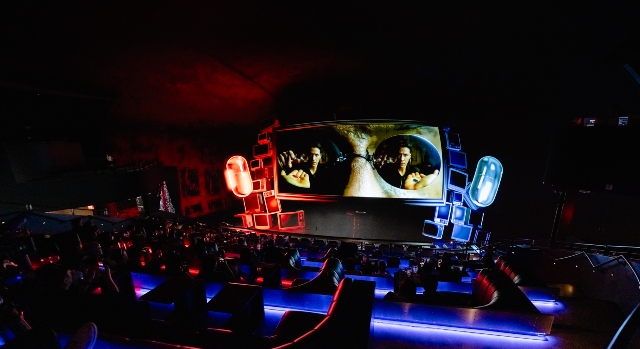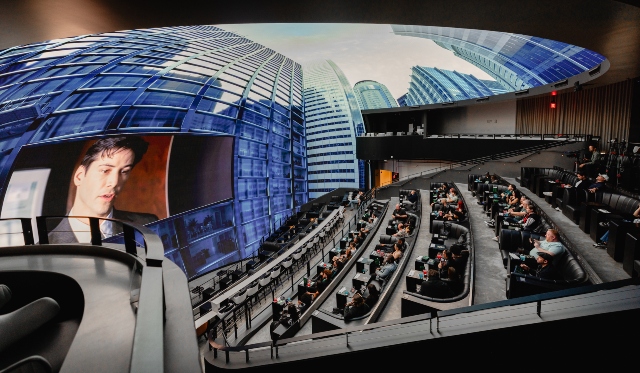Review: ‘The Matrix’ in Shared Reality at Cosm (Dallas, TX)

The year was 1999, and my father came into my bedroom to tell me about a trailer for a movie, “We have to see,” he exclaimed. It had an intriguing title: The Matrix. Regardless of the film’s quality, a studio or director could not ask for a slicker movie title than The Matrix. As the film conveys, it burdens the viewer to question, “What is The Matrix?” When the trailer finally aired on my bulky color TV, the visuals were spectacular, with the song “Rock is Dead” by Marilyn Manson echoing its heavy electronic riffs over the footage. A few months later, my father, I, and my cousin sat down at a THX theater, waiting to see if the movie would deliver on its promise. And it exceeded our expectations. March 31st, 1999, would be the last time I saw the film in a crowded theater until Cosm Dallas invited The Cosmic Circus to the exclusive premiere of a new immersive experience called The Matrix in Shared Reality.
A new hope is the goal of Cosm
Many readers may be asking, “What is Cosm?” For those who might remember, last winter, we reviewed the newly renovated Fort Worth Omni Theater. The technology inside the theater is Cosm Technology, featuring an 8K resolution LED crystal dome for attendees. Cosm also controls two additional theaters in Dallas and Los Angeles, which primarily cater to sporting events, using a 20-meter, 5,000-square-foot display that envelopes the audience’s peripheral vision. Having now been there in person, it has a similar shape to The Sphere in Las Vegas, only drastically smaller in scale. The venues make visitors feel like they are courtside at the game while providing access to a full bar and dining menu.
They call this experience Shared Reality, which is supposed to place consumers in the event. The company employs its own film crew to broadcast the game with the appropriate equipment. Additionally, Cosm showcases immersive experiences, for example, the science-based wonder Orbital and artistic visions like Liquidverse, both of which are titles offered at Fort Worth Omni Theater. However, the company signed a multi-film deal with Warner Bros. to produce Shared Reality experiences exclusively at their venues. The first film to get the treatment was the Wachowskis-directed cyber-tech sci-fi classic, The Matrix. The hope in maneuvering to movies was to bring back the exclusivity of moviegoing. To create a theater-going experience that is difficult to replicate at home.

The Matrix in Shared Reality fulfills the hope, but it’s imperfect. Though, when it works, it becomes impossibly exciting. The artistry behind it all stems from Cosm Studios and Little Cinema. Andrew Merkin was a leader behind the added visual elements, explaining that the creative team would have to work on individual sections of the dome due to the expansive screen format. Although I lacked recording equipment to capture more insights, my conversation with Merkin revealed that the effort invested in this project was tremendously time-consuming. Quite honestly, it shows in every frame.
Thoughts on The Matrix in Shared Reality
[Warning: spoilers for The Matrix in this section!]
Cosm Studios and Little Cinema’s The Matrix in Shared Reality offers two individual experiences on the Cosm Dome that occur simultaneously. The film unfolds within the LED display, framed by a rectangular, digitally created movie screen. Outside of the movie playing are fresh visual elements to make attendees feel like they are experiencing the world as the movie plays.
The Matrix in Shared Reality operates on two different wavelengths. The first makes it feel like the movie itself is exiting the film as visual elements within the film exit the screen and slowly fly toward the viewer; for example, the code flying out of the screen in circular patterns. The sensation brought back memories of watching Last Action Hero, where a golden movie ticket causes the movie and Arnold Schwarzenegger himself to enter our world. In these moments, The Matrix in Shared Reality understands the assignment.
The second wavelength could use improvement, especially involving stationary environments around the central movie. At various moments, when the movie would play classic scenes begging for the entire dome to feel more evocative, the manufactured environments around the movie would remain static and motionless. There are touches of activity, such as computers beeping in the background, sparks and noises, and flickering lights. But for the most part, these segments feel less inspired than the others. The hard work is certainly appreciated, but it gives the impression that the creative team was overwhelmed by the scope of work for the Cosm Dome. The impression is speculative, but if true, it is understandable because the format feels like they used The Matrix as their beta test film.
For this reason, the experience was beginning to feel underwhelming, but the final thirty minutes transformed it completely. From the moment Neo decides to save Morpheus from the agents, the screen becomes breathtaking. When Neo asks for guns in the blank white Matrix space, the arsenal of weapons exits the movie screen as they fly by Neo and Trinity. During the subway fight, the entire dome rotates in unison with the bullet time as bullets fly around in slow motion, both inside and outside the movie.

The most spectacular sequence in The Matrix in Shared Reality occurs during the helicopter scene, as Neo grips the rope holding Trinity while the helicopter crashes into the skyscraper. The environment outside the screen slowly rotates around city buildings amidst the action, until it eventually centers on an identical skyscraper. As the helicopter collides, the exterior ripples like water until it explodes; the building beyond the screen ripples in explosive unison. The moment drew applause and cheers from the audience as if they were at a sporting event. Adding to the aesthetic, the theater uses lights around the floor that radiate colors similar to those in the movie. For example, the floor pulses green when code flies around the screen.
Where should Cosm go after The Matrix in Shared Reality?
As a movie lover, just like Cosm, I hope to witness the return of exclusivity in the theatrical experience. One noticeable detail about seeing a movie at Cosm is that it somehow makes cell phones less distracting. Attendees were recording and taking photos, but the screen was so massive and bright that it was hard for a small iPhone to disrupt one’s enjoyment. However, this is not an endorsement for cellphone use at the movies. The experience also brings back the challenge of replicating the atmosphere at home. For instance, no camera can truly capture the Cosm experience. The effort would require a camera crew with the added difficulty of stitching footage together. The time and effort would still be moot because a flat screen cannot replicate the magic.
The economic aspect is the one concern. Before receiving the invitation, I visited the Cosm website to purchase a ticket for The Matrix in Shared Reality. An accessible seat on the third level costs between $40 and $55, and to our knowledge, this price does not include food or beverages. Adding potential drinks or food to a single ticket pushes it close to the $100 mark. The cheapest option is on the first level, which can cost around $35, but attendees might need a neck brace after the movie due to the enormity of the screen. The price point is understandably alienating given the current climate, especially with regular theaters like AMC raising prices every year. Cosm and Little Cinema are likely trying to recoup costs since they helped create this experience. Still, it’s not a welcoming price point for the average moviegoer.
Regarding the movie itself, as a proof of concept, it’s an admirable start with growth potential. The aesthetic recalls the now-defunct T-2 3D: Battle Across Time at Universal Studios. This experience combined a 3D movie with live-action stage actors performing stunts around the screen. Here, all the exterior stunt work and added elements occur within the LED screen. James Cameron actively collaborated with Universal to bring the T2 ride to life. It would be thrilling to see a filmmaker work alongside Cosm, designing their interpretations of what the audience should experience with this experimental format. Notably, Drew Goddard, who is attached to The Matrix 5, attended the Cosm LA premiere, which suggests a possible path for the future.
That said, before the movie began, Cosm previewed other experiences, such as sporting events and underwater glimpses of sea life filling the entire screen. While The Matrix in Shared Reality is a fun concept, the moment Cosm Studios manages to create a camera capable of producing a movie in this format, no amount of cost could deter me from wanting to experience it immediately. To find out more about Cosm and The Matrix in Shared Reality in Dallas and L.A. and other experiences, visit the official website cosm.com.
Also check out: Fort Worth Omni (IMAX) Theater Returns with Game Changer Technology


